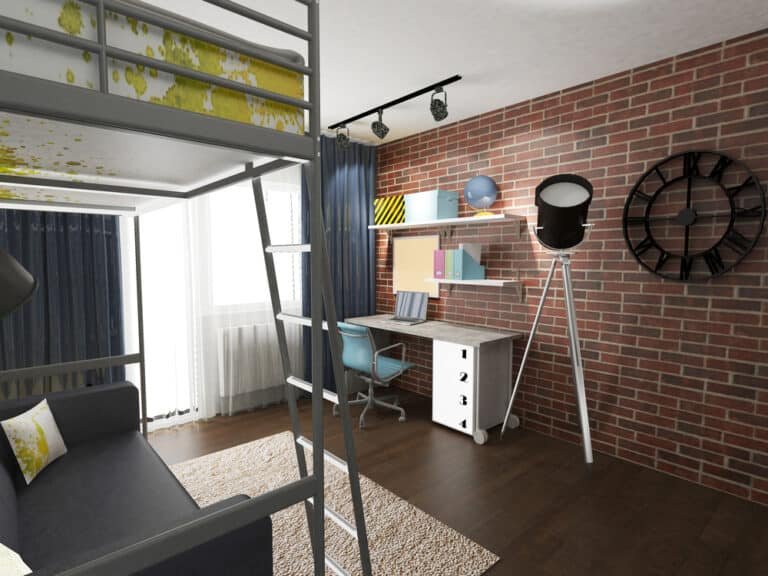Murphy Bed vs Wall Bed (The Key Differences)
Homebody Forever is reader-supported. We may receive a commission if you make a purchase through a link on this post.
If you live in a small space and have tried to find ways to save space, you’ve probably come across Murphy beds and wall beds.
You might wonder what the difference might be between the two. And to be honest, most experts also don’t have the foggiest idea.
Read on to find out what differentiates the two.

What is the difference between a Murphy bed and a wall bed?
The terms ‘wall bed’ and ‘Murphy bed’ are often used interchangeably, and quite frankly, the modern wall and Murphy bed have morphed into basically the same thing.
Traditionally, there were subtle differences between the beds—a few of these differences still exist today.
The history
I promise not to bore you with countless details, but understanding the bed’s histories will improve your understanding of their subtle differences.
Murphy bed beginnings
William Lawrence Murphy patented the Murphy bed in the 1900s. His invention came about after he lived in a space-deprived apartment in San Francisco and decided enough was enough.
The Murphy bed was his space-saving solution, which continues to be used today.
The bed was hinged on one end and utilized a spring-driven mechanism and a metal frame. This clever design enabled the bed to be stored out of sight in a cabinet while blending into its surroundings.
Wall bed beginnings
The wall bed dates to the 19th century, and sadly no single inventor can be pinpointed to thank.
This bed type was similarly created to save space and could easily be stored vertically against a wall. In addition, it typically came with cabinets on either side of it.
This made it appear as part of a regular wall (in its upright position) and made mounting it anywhere in a room simpler.
The wall bed was traditionally and continues to be built with a wooden frame and legs and is typically piston driven. However, cheaper options may come with no lifting mechanism at all.
What has changed?
Wall beds have remained similar and widely unchanged from their original design. However, it’s the Murphy bed that has undergone several sizeable changes.
Although Murphy beds still come with metal frames, legs, and spring mechanisms, many wood options are now available.
Murphy beds have also evolved to offer a range of features, including built-in cupboards and desks (to name a few). In addition, they now offer both spring and piston lifting mechanisms.
Nowadays, is there a difference?
These days, both bed types are very similar, and often the name ‘Murphy bed’ or ‘Wall bed’ mean one of the same things.
One can point out a few subtle differences (for the fastidious and pedantic individuals out there).
But, as a whole, both bed types offer similar features and designs, and the differences are often negligible, if at all noticeable.
Here are a few of those slight differences that can occasionally present.
Assembly and installation
In general, wall beds are known as being simpler to assemble and install than Murphy beds.
This, of course, will depend on the design of the beds, but at large, you can expect an easier assembly and installation with a wall bed.
Wall bed
Wall beds often arrive mostly pre-assembled, which makes the installation quicker and easier. However, it can make life tricky if you have narrow corridors or doorways in your apartment or home.
You do not typically need professional assistance when installing a wall bed, as the pre-assembled parts make it considerably simpler to install and assemble.
Murphy bed
Murphy beds can often be delivered in multiple parts, and you will most likely need the help of a professional if you don’t have the necessary skills.
In addition, installing or assembling a Murphy bed incorrectly can be unsafe and may lead to a bed that works poorly or works defectively.
Floor mounting requirements
Wall bed
Wall beds generally use a gas piston lifting mechanism and, as a result, do not need to be mounted to the floor. This saves time when installing as well as future floor damage.
Murphy bed
Today, Murphy beds can come with piston or spring mechanisms, depending on their price and size.
However, if you purchase a spring-lift Murphy bed, you may need to mount the bed to the floor, which will add to your costs.
Spring-lift mechanisms are also less durable than piston mechanisms and may need more frequent repairs or replacements.
Space saving capabilities
Wall bed
Wall beds often come with small built-in cabinets on either side. Although this will minimize space wastage, you will also have less available storage space.
Of course, not all wall beds come with minimal storage, but a fair number tend to come with smaller cabinets to allow for easier installation and to lessen their overall footprint.
Murphy bed
Murphy beds can be custom-made to suit your needs and storage needs.
Although this may be costly, a fair number of high-end stores and manufacturers will allow you to choose and decide on the extent of storage and cabinetry you require.
You can also include multiuse features by adding a desk or sofa to your Murphy bed design, which is often an unavailable feature for most ordinary wall bed designs.






